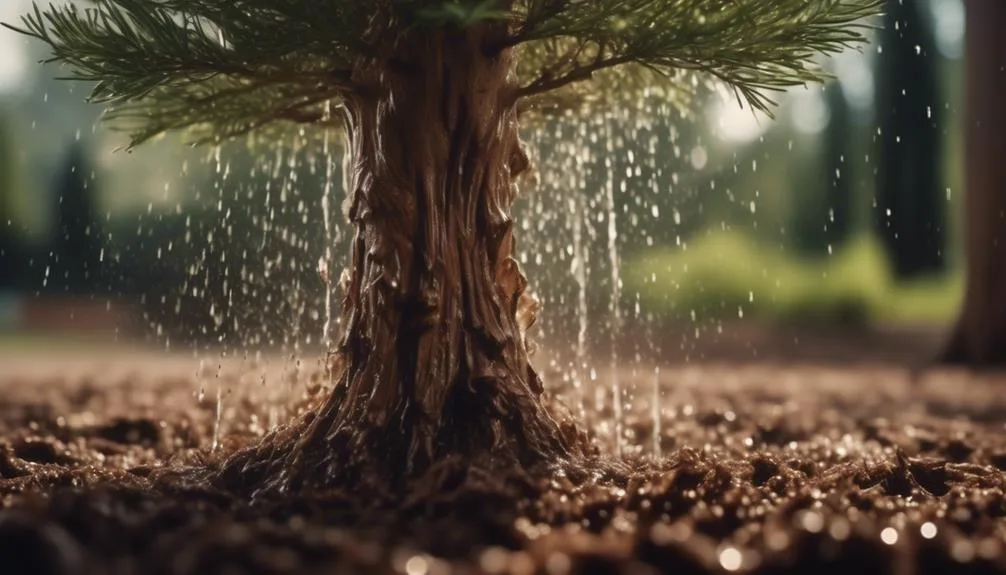Cedar trees bring a timeless beauty to any garden or forest. To keep them healthy and beautiful, it's crucial to water them properly. Balancing the right amount of water without over-soaking the soil is essential.
In this article, we'll explore the best techniques for watering cedar trees. By understanding these practices, you can ensure the trees stay vibrant and strong for years to come.
Understanding Cedar Tree Water Needs
To ensure optimal health for your cedar trees, it's crucial to understand their specific water needs and how best to meet them. Cedar trees have shallow root systems, spreading widely but not deeply. This means they're particularly sensitive to moisture levels in the soil.
To support their root systems, it's important to water cedar trees deeply and infrequently, allowing the soil to dry out slightly between watering to encourage the roots to grow deeper in search of moisture. Optimal moisture levels can be achieved by providing around 1 inch of water every 10-14 days, depending on the climate and soil type.
Choosing the Right Watering Schedule
Consider the specific climate and soil conditions in your area to determine the most suitable watering schedule for your cedar trees. Proper watering is essential for the health of cedar trees, as it directly impacts soil moisture and water absorption.
To choose the right watering schedule, follow these guidelines:
- Climate Consideration
- Evaluate the average annual precipitation in your area.
- Adjust the watering schedule based on seasonal variations in temperature and rainfall.
- Soil Conditions
- Check the soil type and drainage capacity.
- Modify the watering frequency according to the soil's ability to retain moisture.
Utilizing Proper Watering Techniques
Assessing the specific moisture needs of your cedar trees and employing effective watering techniques is crucial for maintaining their optimal health and vitality. Deep root watering is key to ensuring that water reaches the lower levels of the soil where the cedar tree roots can absorb it, promoting healthy root development.
When watering, focus on delivering a slow, steady flow of water directly to the base of the tree, allowing it to penetrate deeply into the soil. Drip irrigation systems are particularly beneficial for this purpose, as they provide a consistent and controlled supply of water, preventing wastage and ensuring that the roots receive adequate moisture.
Identifying Signs of Overwatering and Underwatering
After ensuring that you have utilized proper watering techniques such as deep root watering and drip irrigation, it's essential to be able to identify signs of overwatering and underwatering in your cedar trees to maintain their optimal health and vitality.
- Signs of Overwatering:
- Yellowing or browning of needles, particularly at the tips.
- Soil that feels constantly wet or waterlogged around the tree's base.
- Signs of Underwatering:
- Wilting or drooping of foliage, often starting at the tips and progressing inward.
- Dry, crumbly soil that pulls away from the sides of the planting hole.
Monitoring soil moisture and observing the health of your cedar tree's roots are crucial in identifying overwatering and underwatering issues. By recognizing these signs early on, you can adjust your watering schedule to ensure the optimal health of your cedar trees.
Adjusting Watering Practices for Seasonal Changes
As the seasons change, it's important to adjust your watering practices for your cedar trees to ensure their continued health and vigor.
During summer drought, it's crucial to monitor the moisture levels around your cedar trees regularly. Increase the frequency of watering during prolonged dry spells, ensuring that the soil around the trees remains consistently moist but not waterlogged. Consider using mulch to retain soil moisture and reduce water evaporation.
In contrast, during winter, it's essential to focus on hydration through deep watering before the ground freezes. This ensures that the cedars have enough moisture to sustain them through the colder months. Be mindful of the balance between maintaining hydration and preventing waterlogging during winter.
Conclusion
By understanding the water needs of cedar trees and applying proper watering techniques, you can ensure their sustained health and growth. Adjusting watering schedules and practices according to seasonal changes will prevent overwatering or underwatering.
Observing signs of distress and adapting your approach will help your cedar trees thrive. Consistent care and attention to watering needs will support their well-being in the long run.

My interest in trees started when I first saw the giant sequoias in Yosemite.
I was a teenager then, and I remember thinking, “I need to learn more about this.”
That moment stuck with me.
A few years later, I went on to study forestry at Michigan Tech.
Since graduating, I’ve worked in a mix of hands-on tree care and community education.
I’ve spent over ten years helping people understand how to plant, maintain, and protect the trees in their neighborhoods.
I don’t see trees as just part of the landscape.
They are living things that make a real difference in our daily lives.
